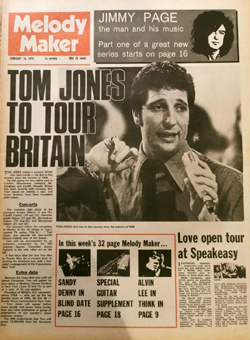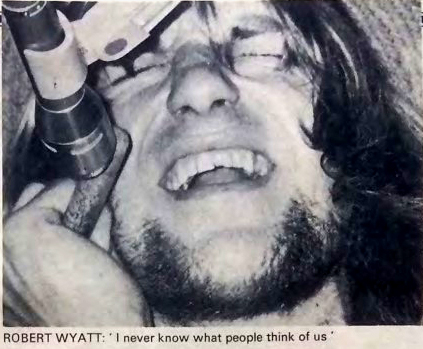| |
|
|
 A child of the pop scene - Melody Maker - February 14, 1970 A child of the pop scene - Melody Maker - February 14, 1970
A child of the pop scene
by RICHARD WILLIAMS
ROBERT WYATT is the member of the Soft Machine you're most likely to be watching while you listen to their music. Tousle-haired and athletic behind his drum kit, he has (he has the kind of natural showmanship which does not compromise the quality of the music he’s a part of.
Reviewing their recent Fairfield Hall concert, I commented that it seemed paradoxical that, while the group are progressing rapidly, the audience is still managing to catch up with them.
“Perhaps there’s an element of flattery involved,” says Robert, “in that we expect them to follow anything we feel we want to do.
“But we can never really gauge for ourselves what he audience is feeling because we don’t stop for applause. Now that even the break in the middle has gone, we’ll play for a minimum of one and a half hours and come straight off. So we only feel any sort of reaction when we’re changing afterwards.
“Our sort of progression is the kind in which the musicians improve as they play, gaining more control over their instruments and pacing themselves better. This is something that everyone has to learn, and that’s what’s happening to us.
“I never know what people think of us. It’s quite mystifying. We can come off stage and Mike’ll be quite depressed while I’m turning cartwheels.
“We’re not an intellectual group – if we were, we wouldn’t get anywhere. We don’t even talk about it any more, and it just happens in a subconscious sort of way. Because Mike is musically highly educated doesn’t mean we aren’t intuitive.
“We don’t spend enough time in rehearsals for Mike and we spend too much time there for me, because I can only discover things in the act of playing the piece, in a performing situation.
‘It’s like painting in a way. Some painters do sketches first, but often the whole thing is the work itself. I use time like a painter, putting layers on; the first set starts out casually, and then I build it up as I get into it. It’s really very elastic.
“The basic thing is to find the right people to work with, and after that you commit yourself to working round whatever they’re doing. If I thought there was anybody playing something really fantastic, I’d want to work with them – and for me that’s Mike, Hugh, Elton, and Lyn.
 |
“Hugh’s bass playing is the most interesting new thing for me. He’s doing things to the bass that I’ve always wanted people to do at this level. When he solos he might play high and fast, but he always keeps the kind of weight and authority that the bass should have. When he races up to the top he doesn’t leave a gap at the bottom.”
About audiences, Robert comments:
“I’ve always found British audiences to be the least idealistic of all. The French and the Dutch kids really want something else to listen to, and they don’t want to feel they’re being hyped.
“The whole atmosphere in Britain, when you’re dashing up and down the MI, is different. For instance if the PA goes wrong, there’s less urgency to get it fixed. Maybe this is because Britain is home, and we don’t feel the sense of occasion that we get abroad. That’s probably our own fault, because some groups are very conscientious about every gig.
“The university audiences and the militant Left have little to do with what I’ve got to say. In West Berlin… people ask us why our songs aren’t more politically committed, and why we charge entrance fees, and “Whose side are you on anyway?” The best audiences are primarily interested in the music”.
Robert’s singing is an interesting feature of the group, and about this side of his performance he says:
“I’m completely a child of the pop scene. When it comes to drawing inspiration for one of Mike’s time signatures, I go and listen to
Sly or James Brown. That’s more poppy than most pop people listen to.
“The voice came from a need for a particular sound. I can’t pitch accurately low because of the nature of the instruments, so I sing high. It’s also better to keep tonally blank and let the clear note come through.
“It’s also a slightly social thing, in that it’s the closest I can get to talking to the audience. I haven’t got Lyn’s thing about the voice being the source of all sound, and it took a long time to figure out how to use it. Singing songs was obviously out with this band, and Syd (Barrett) has been a big influence. It’s an unaffected thing, just straight words really.
“But what I was saying about the pop thing: if there has been any grafting on to our music, pop music was the last thing to be grafted on.
Nevertheless in ways we’re completely opposed to what happens in jazz, where people extend themselves all the time. We all feel the pressure to the drums. It clears the overall conscious of the editing aspect of performance.”
Among the changes which Robert is making in his playing is the use of snare-drum with the snares off, making the drum into a third tom-tom, pitched higher than the others.
“I’ve been doing that and playing nearer the rim of the drum, to get a ringing sound. This changes the whole nature of the kit, and removes the cymbals from their usual relationship to the drums. It clears the overall sound and makes a lot more space, because the sound with cymbals and snare going with the other instruments can be very muddy.”
Robert’s technique fascinated me the first time I saw him. He plays not so much like a conventional kit drummer, but more like a tympanist, with that fluid movement around the drums which comes from the arms rather than the wrists.
“I learned from a jazz drummer, who taught me to play with my elbows in, using my wrists like Philly Joe Jones. But I never really mastered it, and anyway you can’t get the volume or intensity that way, so I rather let it go and started using my forearms more.
“I’m seriously considering taking the snare drum away from the centre of the kit and putting it more to one side, so that I can get away from the Buddy Rich thing and use it more for accents.
“The kit I use was given to me by Mitch (Mitchell), who had it custom built in the States out of Maplewood. When I sit down behind it it’s like being in a little room, it’s very comfortable.
“If jazz drumming has had any influence on me, it’s been in teaching me what not to do – although I hope that doesn’t sound arrogant. Some drummers have all this jazz training and just do it all wrong. For me, it’s really all down to James brown’s rhythm section.”
Richard Williams
|



